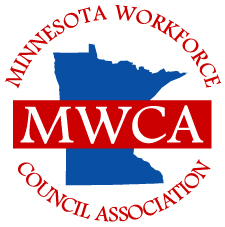- MN ABE Connect
- Archive
- WIOA Regional Planning Underway
WIOA Regional Planning Underway
Anne Kilzer, DirectorWorkforce Innovation and Opportunity Act: An Overview of State, Regional and Local Planning
As you are well aware, the federal Workforce Innovation and Opportunity Act (WIOA), passed in the summer of 2014, made several changes to the workforce development system and how it operates.
One significant change is the addition of a new planning process. In addition to a plan from each state and a plan from each local workforce development area, or WDA (formerly workforce service area), WIOA requires the Governor to create regions made up of local areas, and each region must submit a regional plan.
In Minnesota, Governor Dayton has designated six regions; five are rural and made up of two WDAs each; the sixth is made up of the six WDAs in the metro region.
 Red – Regional Workforce Development Area 1
Red – Regional Workforce Development Area 1
- Local Workforce Development Areas 1 and 2
- Purple – Regional Workforce Development Area 2
- Local Workforce Development Areas 3 and 4
- Green – Regional Workforce Development Area 3
- Local Workforce Development Areas 5 and 17
- Blue – Regional Workforce Development Area 4
- Local Workforce Development Areas, 9-16
- Orange – Regional Workforce Development Area 5
- Local Workforce Development Areas 6 and 7
- Yellow – Regional Workforce Development Area 6
- Local Workforce Development Area 8 and 18
Although these new regions are mandated by the law, they do not replace local workforce development areas. Local areas meeting performance and financial auditing standards are allowed to maintain their local designation. In the fall of 2015, Governor Dayton officially granted each of Minnesota’s sixteen workforce service areas designation under WIOA.
According to WIOA, the purpose of the regional plans are to improve strategic coordination (better alignment of related systems; improve the structure and delivery of services) and better results for jobseekers (strategies to increase access to workforce development services; credentialed skills providing sustainable wages and workers; and improving the prosperity of workers and employers). WIOA requires that the areas be consistent with labor market and economic development areas and have adequate resources available to carry out activities.
The development of Minnesota’s state WIOA Plan is being led by the Department of Employment and Economic Development (DEED). A draft plan will be made available for public comment prior to being submitted to the Federal Department of Labor. The regional and local plans are the responsibility of the Workforce Development Board (formerly Workforce Investment Boards). Planning guidance was developed by DEED. That document outlines the following framework for regional and local plans.
REGIONAL LEADERSHIP APPROACH – What is the region’s story and strategy?
The regional leadership approach describes how the local area boards within each regional workforce development area will define and coordinate the strategic priorities established by the Governor under WIOA.
The strategic planning component of the Regional Plan addresses three elements: strategic analytics, strategic approach and strategic operations. The overarching theme is to engage regional stakeholders in the process of establishing the strategic plan and to ensure that decisions are data driven and that the data can be used to measure gains and identify needs for improvement.
LOCAL STRATEGIC PLANNING – How will the approach be implemented locally?
The core elements of strategic operations focuses on operating policies and procedures related to the one-stop system and physical locations of service delivery.

WIOA mandates that partners be involved in regional planning efforts. Each of Minnesota’s six regions is currently working toward writing their regional and local plans; each is using a locally-driven approach and timeline. It is important to note that, as indicated by the planning guidance, this year’s regional plan is intended to outline a strategy to meet the intentions of, and begin the implantation of WIOA.
If you are interested in the regional and local efforts happening in your area, you are encouraged to reach out to the ABE representative on your local Workforce Development Board or your local workforce services director. If you have more general questions about the requirements, process and timeline, feel free to contact Anne Kilzer, director of the Minnesota Workforce Council Association, at [email protected] or 651.789.4323.

Newsletter Signup
Get MN ABE Connect—the official source for ABE events, activities, and resources!
Sign UpArticle Categories
- ABE Foundations/Staff Onboarding
- ACES/Transitions
- Adult Career Pathways
- Assessment
- CCR Standards
- Citizenship
- COVID-19
- Cultural Competency
- Digital Literacy/Northstar
- Disabilities
- Distance Learning/Education
- ELA
- Equity/Inclusion
- ESL
- HSE/Adult Diploma
- Listening
- Math/Numeracy
- Mental Health
- Minnesota ABE
- One-Room Schoolhouse/Multilevel
- Professional Development
- Program Management
- Reading
- Remote Instruction
- Science
- Social Studies
- Speaking/Conversation
- Support Services
- Teaching Strategies
- Technology
- Uncategorized
- Volunteers/Tutors
- Writing